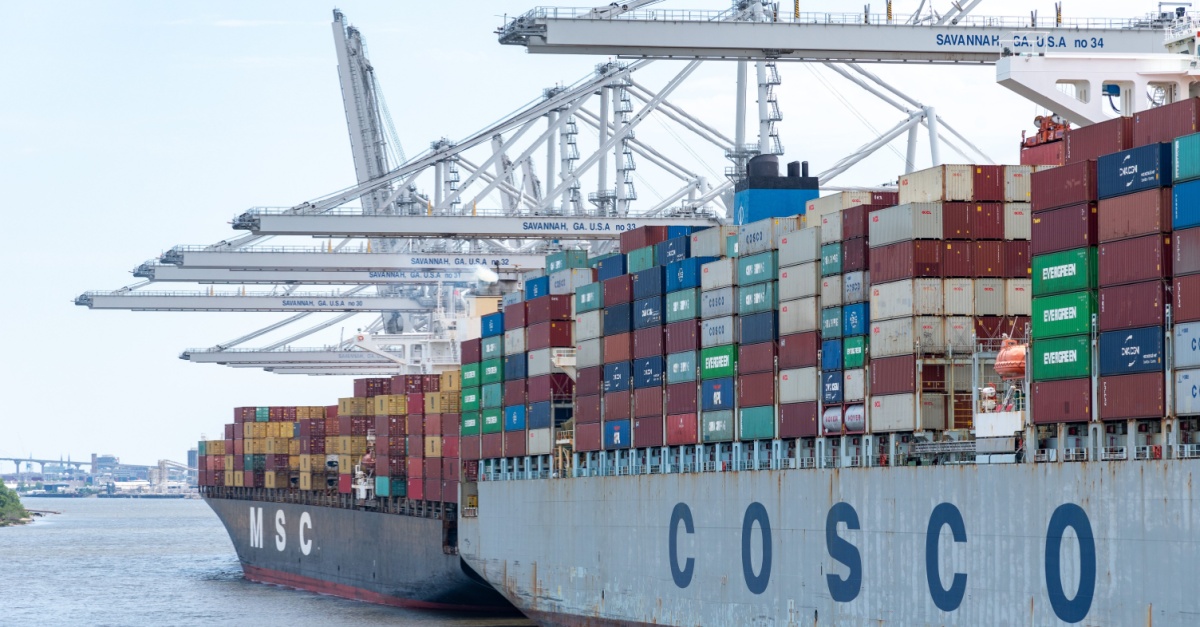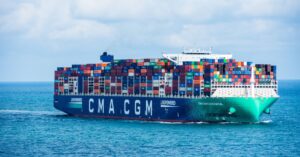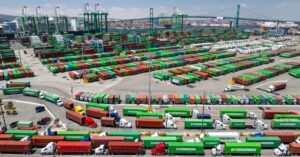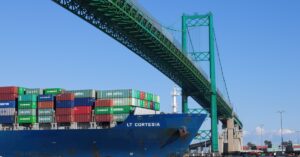The trade war and its wild swings in tariff rates have thrown supply chain forecasts into turmoil. One month, ocean rates look stable; the next, front‑loaded inventory surges drive spot rates skyward. Meanwhile, rates on key import lanes can spike overnight, upending landed cost calculations and exposing hidden fees. And the negotiation beat, both bilateral and between the U.S. and nation blocs, continues.
While trade policies lie beyond a shipper’s control, you can insulate your logistics budget through three core strategies: diversifying modes and gateways; blending contract and spot capacity with 3PL partnerships; and leveraging technology and data for real‑time decision-making.
Diversify Modes and Gateways
Rigid reliance on a single transport mode is a recipe for cost shock when tariffs ripple through carrier rates or fuel price escalators. By building true intermodal flexibility through shifting volumes among ocean, rail, and truck, you gain the agility to route around high-cost gateways or congested ports.
For example, when increased rates to the West Coast drive up container costs, you can redirect through Gulf ports, then move containers by rail to inland hubs. This not only locks in lower per‑mile rates but also avoids peak season demurrage charges and vessel delays. Conversely, if rail surcharges spike, you can reassign loads back to truck or short‑sea services.
Alternative Gateways and Nearshoring
Not all U.S. ports carry the same tariff exposure or congestion risk. Secondary gateways like Savannah, Mobile, and Baltimore sit outside the busiest Pacific and Atlantic ports and have lower fees. For example, Savannah’s per‑TEU wharfage might be 10%-15% lower than Los Angeles, directly affecting landed costs.
Redirecting container volume through these ports can trim ocean freight costs and streamline customs clearance via smaller inspection queues. Similarly, sourcing from suppliers in Mexico under USMCA or from Southeast Asia under smaller bilateral tariffs eliminates or reduces duties. Couple that with cross‑border drayage corridors for final delivery, and you sidestep large duty swings while shortening transit times and lowering inventory costs.
Blend Contract, Spot, and 3PL Partnerships
Locking in long‑term contracts for roughly 75% of your freight volume provides baseline rate stability as tariffs gyrate. Modern agreements can include built-in fuel and tariff surcharge pass‑through clauses. This means when duties rise, your base rate adjusts automatically within agreed floors and ceilings, preserving predictable landed costs without renegotiating.
Mini‑Bids and Spot Top‑Ups
For the remaining 25% of volume, adopt rolling micro‑RFPs (aka mini‑bids) that tap the spot market without exposing your entire network to wild swings. These short‑window tenders capture transient dips in spot rates, letting you top up capacity at lower costs when spot rates dip. Importantly, mini‑bids can be automated via your TMS, so you’re not manually chasing quotes in a volatile market.
Strategic 3PL Alliances
Partnering with a 3PL that operates a broad multi‑carrier network and offers intermodal brokerage amplifies your negotiating leverage. A well‑capitalized 3PL can bundle warehousing, drayage, cross‑border trucking, and ocean or rail bookings, yielding volume discounts you can’t access alone. They can also deliver reliable expedited freight solutions when transit time needs to shrink.
Equally important, the 3PL absorbs execution risk, managing carrier allocations, equipment shortages, and disputes that arise around accessorial fees. Your team is freed up to focus on procurement and customer service rather than micromanaging logistics exceptions.
Leverage Technology and Data
A modern TMS unifies rate shopping across all modes, lanes, and duty tables into a single dashboard. With one click, you compare ocean, rail, and truck landed costs, including projected fuel and tariff surcharges. This ensures you always tender via the lowest cost, service compliant route. Integrated optimization engines can even recommend route shifts when a sudden tariff announcement makes one corridor uncompetitive.
Visibility and Predictive Analytics
Visibility platforms ingest GPS/ELD telematics, carrier EDI feeds, and yard events to track every shipment end to end. Overlaying that data with predictive analytics lets you simulate “what if” tariff scenarios, forecasting duty spikes and automatically triggering alternative routes or mode shifts before costs spike.
For instance, if a 20% increase in steel import duties is announced, the platform can highlight exposed lanes and recommend rerouting steel coil shipments via a lower duty origin or alternate port.
Collaborative Portals
Tariff volatility demands proactive dialogue among shippers, brokers, carriers, and 3PL solutions. Shared portals allow you to publish volume forecasts, view carrier rate trend dashboards, and broadcast exception alerts in real time.
This transparency fosters cooperative negotiations on rate adjustments and capacity planning, helping you avoid being blindsided by a sudden surcharge or capacity shortfall. It also empowers late-stage collaboration: If a tariff deadline is extended, you can quickly reroute pending bookings without rekeying data across systems.
Putting It All Together
In practice, these strategies reinforce one another. Mode diversification gives your TMS more options to optimize; spot‑contract blending stabilizes your budget; 3PL partnerships inject execution agility; and data platforms make the entire network visible and controllable. The ultimate benefit is a freight program that treats tariff shocks as manageable variables rather than existential threats, delivering both cost savings and service resilience.
Diversification Mitigates Risk as Trade Shocks Continue
Diversification across transport mode, gateway geography, contract structure, and partner ecosystem is your hedge against the unpredictable tides of global trade policy.
At COGISTICS Transportation, we specialize in architecting resilient freight networks, integrating nearshoring strategies, multimodal routing, flexible contracting, and cutting‑edge technology into a unified solution. The latter includes real-time tracking, digital documentation, and powerful analytics, providing visibility and control over all shipments.
COGISTICS Transportation is also committed to reliable 24/7 support across land, air, and ocean freight operations. Our dedicated teams are always on call to manage disruptions, troubleshoot exceptions, and ensure smooth freight execution.
With decades of proven experience in industries that demand precision and performance, COGISTICS Transportation is your trusted partner, helping you ship smarter, faster, and more efficiently.
To learn how we can stabilize your logistics spend and keep your supply chain moving, no matter what the tariff winds bring, reach out today.




